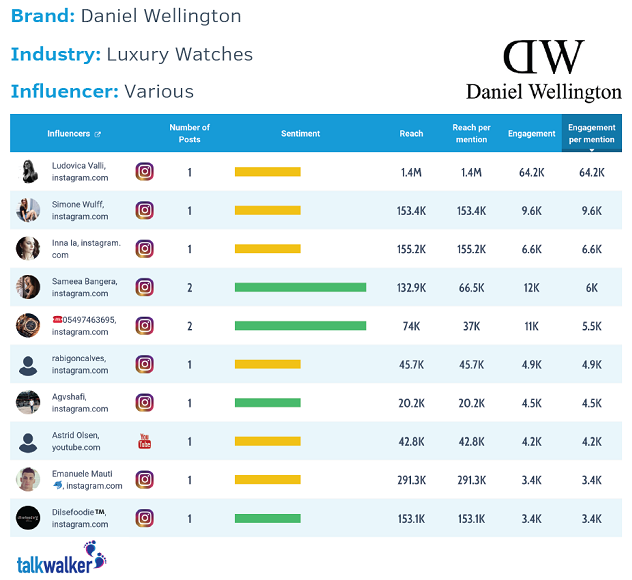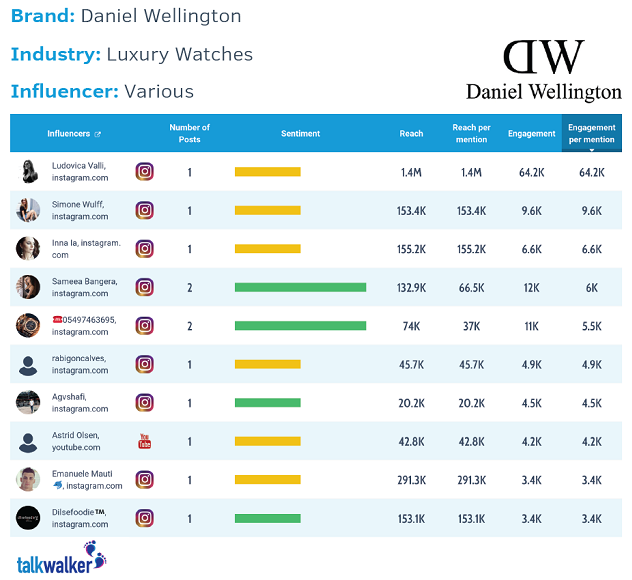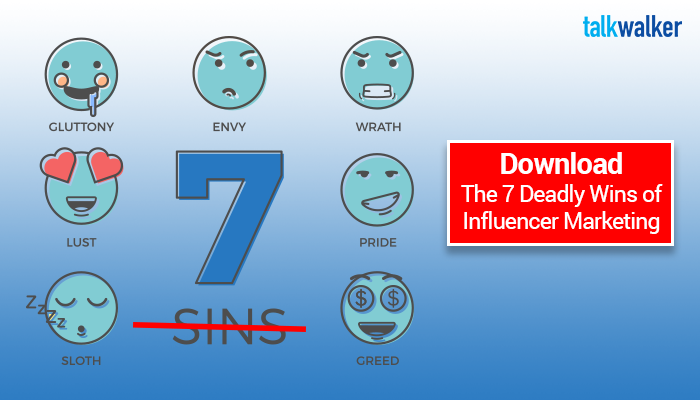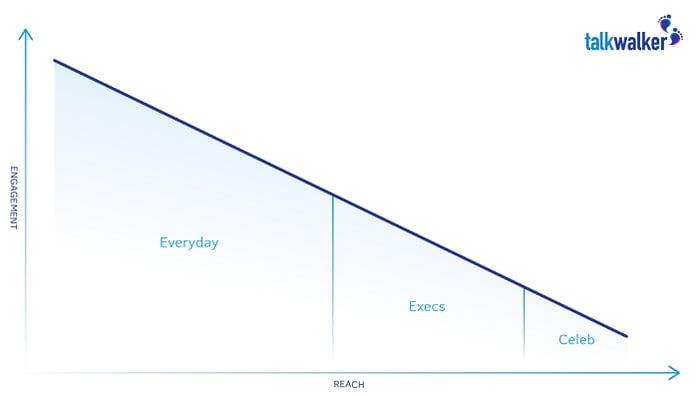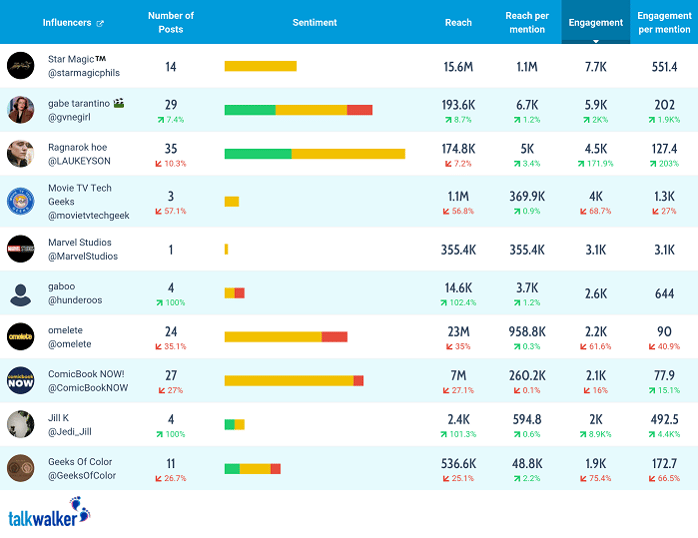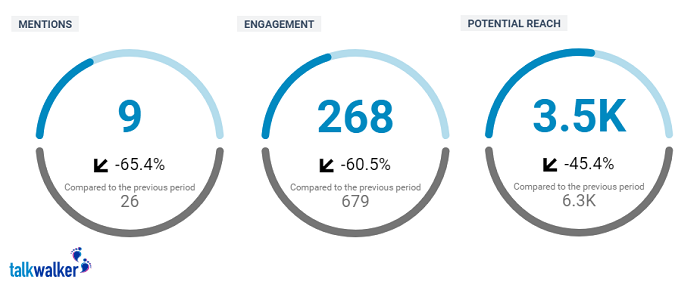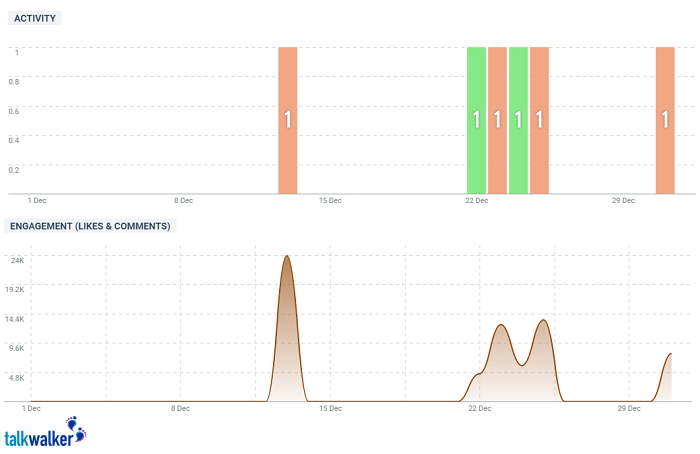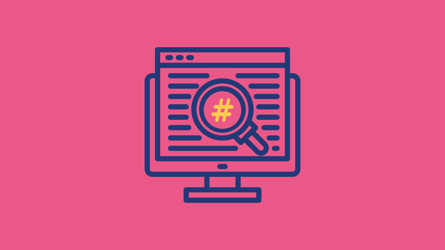Download Global State of Influencer marketing report!
Check out what 800+ marketing and PR experts think in our Global State of Influencer Marketing report.
Anyone can be an Instagram influencer. You, me... that cyborg over there. The industry is huge. Last count? $2 billion! By 2020, its value is estimated to increase to $5-10 billion!!!
Okay, enough exclamation marks. You get the picture.
Below, you can see how luxury watch brand, Daniel Wellington, used celebrity and macro Instagram influencers to reach a massive audience, without having to rely on traditional marketing.
Instagram influencers - taking over the world one follower at a time.
Brands, looking to authentically promote their products to consumers, have leapt onto the influencer marketing bandwagon. With image-based Instagram, eclipsing other social media platforms.
Check out our survey - The global state of influencer marketing. There are some cracking stats from 800+ marketing and PR experts.
Despite the many articles claiming influencer marketing is a new thing, it’s not. Really. It’s not. In 1890, the Davis Milling Company hired Nancy Green to be the spokesperson for its brand. Aunt Jemima was born. The Marlboro Man rode into our lives in the 50s. And, Coca-Cola used a jolly, well-built guy in a red suit to sell its fizzy pop.
What is relatively new about influencer marketing, is the emergence of social media. And it’s a match made in heaven.
Be an angel - download your free Instagram marketing strategy checklist - and reach for the stars!
download instagram marketing strategy checklist
A freebie used to be payment enough. Now, with the influencer industry growing, we’re talking serious money. With top Instagram influencers asking for $1000 per 100,000 followers. For celebrities, you’re looking at $250,000+ per Instagram post.
I think we can agree that Instagram is at the forefront of influencer marketing, so I’ll concentrate on Instagram influencers in this guide. The what. The why. The how. Don’t forget to grab your free winning at influencer marketing checklist.
Here goes...
Table of contents
- What is influencer marketing?
- How Instagram influencer marketing will benefit your brand
- Definitions of an influencer
- What campaigns can you run with Instagram influencers?
- How much do Instagram influencers cost?
- 3 steps to a winning Instagram influencer campaign
- How to choose the best influencer for your brand
- FTC guidelines - keeping it honest
- The only Instagram influencer marketing tool
- Takeaway
What is influencer marketing?
It’s there in front of you, everytime you take a stroll through social media. Squeezed in between your friend’s holiday snaps and your brother’s wedding. A person demonstrating how great your life would be if only you drank the right smoothie.
Did you buy into it? Did you buy the brand? Boom! You’ve been influenced.
Savvy marketers, recognizing the power these guys wield, are falling over themselves in an attempt to exploit the potential of influencer marketing.
Influencers drive authentic conversation about a particular industry, topic, brand, niche. They drive engagement. Followers can be a few hundred, or a few million.
Consumers are no longer influenced by traditional marketing techniques, such as TV ads. When we research a new product, we turn to social media. We read and believe influencers. We trust them.
“As the world has shifted to social media, consumers look at fellow consumers to inform their purchasing decisions. Instead of looking at companies, as they did in the past, they now look at each other and at their favorite personalities.” AdWeek
How Instagram influencer marketing will benefit your brand
If you want to present your brand to an audience on Instagram with an authentic voice, you have no choice. You have to use influencers. If you want to be heard over the social noise, fight your way through the ad blockers. You have one choice - bring in the influencers.
BTW - this post is about Instagram influencers, but the insights also apply to working with influencers on other social media channels - Twitter, Facebook, LinkedIn, YouTube, etc.
Brands are reaping the rewards of working with influencers - engagement, ROI, brand awareness.
Track your campaign with our virality map, and you’ll see how your influencer’s message is diffusing around the world.
Engagement
Creating authentic marketing content that resonates with consumers, is a challenge. We’re bombarded every day, all day. It’s mind numbing. Unless the content triggers engagement, it’s failed.
Influencers have cornered the market. They’re posting authentic content, and their followers are engaging with it. They trust these guys, even when they’re going in for the hard sell.
Return on investment
“Influencer marketing delivers 11X higher ROI than traditional forms of digital marketing and 94% of marketers who used influencer marketing believe the tactic to be effective.” Invesp
Says it all.
Brand awareness
Great product. Any customers?
If no one has heard of you, how will you ever make it big? Working with Instagram influencers will bring you the exposure your brand needs. Work with influencers to...
- Promote your product to their followers
- Boost your follower growth
- Demo your product to prospects
- Increase trust in your brand with reviews and engaging content
Instagram is, in my opinion, the best social media channel for brands using influencer marketing.
- Social action is high, compared to other platforms
- Use multiple photos and videos in a single post
- Tagging and linking features
- Character limit is a crazy 2000+
- Instagram followers are more engaged than Facebook
- Target ads based on user location, age, gender, interests
When Instagram updated its algorithm, business accounts suffered. Reach was limited. Instagram influencer marketing has stepped up to the plate, and become an essential part of a brand’s marketing strategy. With an estimated 71% of US companies using Instagram marketing.
Definitions of an influencer
A person that influences others’ behavior or opinions. In marketing, we’re talking purchasing decisions.
Mega/celebrity/A-list
Cristiano Ronaldo. Kim Kardashian.
Brand loyalty and trust… meh!
Macro-influencer
These guys have a follower count of between 100,000 and 1M. They’re not movie stars, singers, or sports people. They made their name via the Internet. Blogging, vlogging, etc.
Their audience is less niche - various locations, interested in different topics. A macro-influencer often covers several topics. For instance, sharing wisdom about copywriting, a macro could also discuss related topics such as SEO, social media, PR, etc.
They’re a brand in their own right.
Advantages of a macro-influencer
Professionals, with their own voice. Influencing is their job.
A larger audience with more reach than a micro. A variety of people, as opposed to the niche audience of a micro-influencer.
Disadvantages of a macro-influencer
Because they’re less niche, their authenticity can be questioned. Social media has made us more savvy. Similar to a celebrity promoting a product, we’re not 100% sure that the influencer is genuinely using the product.
Micro-influencer
Between 1,000 and 100,000 followers. Micros focus on a specific niche or subject, and are considered industry experts, thought-leaders, topic specialists.
These guys aren’t celebrities, but they do have a dedicated and loyal fan-base.
Voir cette publication sur Instagram
In my @jbrandjeans ♡ @steph_shep jeans congrats on the collab #littleblackjean @jasonrenaud
Une publication partagée par MP (@martapozzan) le
Marta Pozzan travels around the world, fashion week to fashion week, promoting brands that include Kenzo, Bulgari, etc.
How do micro-influencers help brands?
Subject experts, trusted by their followers.
Micro-influencers don’t use hard sell to promote products. They tell stories. They have an established audience that trusts them and listens.
Because micro-influencers have less reach, brands have several in their stable. Meaning they increase reach in their influencer campaigns. Using multiple micro-influencers will bring a greater ROI, while reducing marketing spend.
Nano-influencer
With around 1000 followers, these are the new kids on the block. A nano has powerful influence in their community. Their lack of followers is compensated by intimate and personalized messages. They’re regular people - not famous - recommending to their friends and family, and they’re real good at social media.
Why are nano-influencers so powerful?
Limited reach. High level of authority. High engagement rates.
They go deep into their niche markets and, according to a Digiday survey, are able to engage up to 8.7% of their audience. Compared with celebrities with millions of followers, engaging at 1.7%.
- Serve small, niche markets that don’t always have thought-leaders, so nanos have a loud voice
- Few followers, but loyal
- Smaller audience means a nano’s messages speaks to everyone
- Cheaper than micro and macro, and easier to build relationships with
Nano-influencer - Erin Gee.
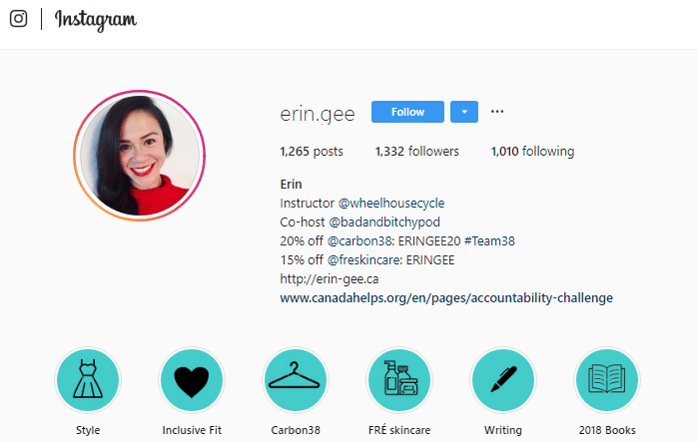
Erin Gee - Instagram influencer - 1,332 followers.
Fré - a skincare brand - discovered Erin’s Instagram account and liked what she was posting. The brand contacted her, asking if she’d test its product and then promote the brand. Payment amounts to freebies. She received brand guidelines, content suggestions, hashtags, and posting times.
Virtual influencer
In 2016, Miquela Sousa - AKA Lil Miquela - arrived on Instagram.
- Miquela is an influencer for Prada, Chanel, Vetements, Supreme, and more
- Miquela is a singer and model
- Miquela raises money for charities and advocates social movements
- Miquela identifies as a computer-generated cyborg
- Miquela is a virtual influencer
Out of this world!
Voir cette publication sur Instagram
Got u an exclusive peek @ my forehead as an early Valentine gift. (Ily.)
Une publication partagée par *~ MIQUELA ~* (@lilmiquela) le
1.5M followers with only 394 posts.
Lil Miquela has a personality and an emotional connection with her followers. She’s built a relationship with her audience.
Does it work for real with a virtual influencer?
The same rules apply as with human influencers. A virtual’s follower demographic has to align with your brand identity.
Lil Miquela is ideal for fashion brands and cosmetics. Not such a match for the finance industry. Her messages would probably fall on deaf ears.
Brands have it easy with virtual influencers. They get the benefits of working with an influencer - reach, engagement, new audience, etc. - without the fear of them going rogue.
Brands can so easily get ensnared in a PR crisis when an influencer ‘misbehaves’. Fallout can irrevocably damage a brand’s reputation. While a virtual influencer won’t get caught in bed with the wrong person, snapped while messing with class A, or post callous, bigoted posts.
Virtual influencers are in their infancy. They’ve caught our attention and for brands, they bring a funky new angle to Instagram influencer marketing.
What campaigns can you run with Instagram influencers?
It depends on your industry, goals, influencers, content, product, etc. Here are the most popular influencer campaigns for promoting your brand and products.
Product-based content
An influencer uses content to promote your product - product placement, reviews, how tos, or testing.
Product placement has the influencer using the product and talking about its benefits. This method can include a ‘how to’.
Nano-influencer, Leticia Collings, demonstrates Remington’s curling wand to her 8,000+ followers on Instagram.
Another method is, brands giving an influencer a product prior to release. They’ll test it and post a review.
Sponsorship
This is when a brand sponsors something that an influencer is involved in - event, tutorial series, etc. By jumping on content that’s already popular and successful, brand recognition and reputation get a boost.
Sponsored content
Sponsored content includes paid campaigns, promotions, and content matching the style of the platform - blog post, social media message, newspaper article, etc. An influencer could wear a clothing brand and post a photo, or include a brand mention in their storyline.
A popular method on Instagram and Twitter, is to promote a hashtag. Usually involving multiple influencers, a campaign can be amplified across the social media channel.
Giveaways, contests, and promo codes are great ways to boost reach and drive engagement. The buzz gets louder and the desire for the product increases.
How much do Instagram influencers cost?
Sorry. There isn’t a one-size-fits-all answer.
Influencer marketing is still relatively new, which means the standards are in flux. It’s so far removed from traditional marketing, that many marketers struggle to incorporate it into their marketing strategies.
There isn’t an established fee structure. I’ve checked out various sources and the average for Instagram is $1000 per 100,000 followers. But, don’t quote me on that.
Many nano-influencers and some micro will work with brands for free products. Unfortunately, because influencer marketing is now so huge, more and more micros are charging.
Macro charge big bucks. For these guys, their Instagram account is their full time job, so of course, they want a salary.
Mega? $$$$$
Don’t blow your entire budget. Work with an influencer your brand can afford.
What’s taken into account when Instagram influencers charge?
Even taking the following into account, prices fluctuate greatly. For instance, HopperHQblog suggests that Cristiano Ronaldo earns $400,000 for every image he posts.
Okay, that’s pie in the sky stuff. Let’s get back to the real world. When charging a brand, an influencer will consider:
- Whether a brand fits with their image and followers
- How many followers they have
- Engagement their posts normally generate
- How many posts the brand wants them to share
- Post type - video, photo, long/short-form content
- How much work they have to do - depending on what the brand provides
- Whether the post will only appear on their account, or be used in other areas of the campaign
Don’t blow your budget!
Before you sign anything, ask yourself…
- Potential reach?
- Potential ROI?
- Is their audience a good match with your brand and product?
- Is it worth the money?
Talk to your influencers. Ask them how they performed with other brands, what were the results?
To help you, you can download my 7 Deadly Wins of Influencer Marketing. It'll walk you through setting up a campaign. What you have to do. What you should avoid. It'd be a sin to ignore...
3 steps to a winning Instagram influencer campaign
These are the three rules of a winning influencer marketing campaign:
- Defined objectives and KPIs
- The perfect influencers for your brand
- Effective measurement and analysis of results
Defined objectives
Your goals should be set before you choose your influencers and launch your campaign. Without them, you won’t be able to measure your success, or failure. Goals could be…
- Increase website traffic
- Drive brand awareness
- Increase followers
- Boost sales
- Create more engagement
The perfect influencer
Fashion brand? Fashion industry influencer.
While that may be obvious to some of you, there are brands that choose influencers based on the number of followers. Shortsighted.
What brands should look for is building a lasting relationship with the influencer and their followers. An influencer who can…
- Engage with your target audience
- Align with your brand’s value and message
- Promote your brand honestly and authentically
Effective measurement and analysis of results
How you measure the ROI of your Instagram influencer campaigns depends on your objectives. Are you looking for more sales? To increase your visibility? More engagement?
Check out what you could measure:
- Visibility - ROI is the number of potential customers waking up to your brand - measured by reach and impressions
- Engagement - measurements include likes, website visits, number of sales, comments, shares, video views, retweets, repins, shares. etc.
- Conversions - track how many times people executed a call to action. Could be sales - affiliate links, promo codes - follower growth, email subscribes, downloads, etc.
How to choose the best influencer for your brand
The type of influencer you choose will be determined by what you want from your campaign.
Don’t be blinded by reach.
Find an influencer in your niche. You’re looking for them to create and distribute relevant, engaging content. Then share it with their audience in an authentic, transparent way.
Talkwalker social media analytics - analyzing the most powerful influencers for Thor Ragnarok, @Jedi_Jill generated nearly as much engagement as @ComicBookNOW, despite less reach.
If you’re not working with the right influencer, you’re wasting your money.
Know your target audience
If you’re selling clothes, target a fashion blogger. Sorted.
Woah...
Fashion bloggers target different audiences. They might not be targeting your audience demographic. For instance, your target audience is predominantly hipsters. Your prospective fashion influencer targets gym bunnies.
I’m not saying that hipsters don’t go to the gym. But it’s not a perfect match. You’re going to miss large segments of your audience. Match your audience with your influencer’s followers.
Align your values
Always look at an influencer’s previous posts before signing them up.
Social media is great for free speech. But what some may consider a just comment, could offend others. An influencer will be representing your brand. Ensure you have the same values. Or damage your brand reputation.
Be authentic. It’s crucial. Almost 60% of digitally savvy female consumers won’t engage with a sponsored post they feel isn’t genuine.
Choose your goals
Understand what you want to achieve from your influencer marketing campaign. Sales, brand awareness, traffic? An influencer should be part of your team. Build a relationship and work with them.
Be prepared for a gaffe
Influencers are human - well, apart from the cyborgs - and humans make mistakes. Having a PR crisis communication plan in place is crucial. So you’re ready. Just in case.
If you’re considering influencer marketing, you can pick up valuable tips in my influencer marketing guide. It includes a free influencer marketing strategy eBook.
FTC guidelines - keeping it honest
Along with the rise of social media, came rules of behavior. The Federal Trade Commision (FTC) guidelines were updated to protect consumers. The commision asks that influencers make it clear that they’ve received payment from brands to promote their products.
I’m not going to replicate the entire document because - keeping it honest - it’s way too long. Here are some highlights.
Endorsements must...
- Be honest and not misleading
- Reflect the honest opinion of the endorser
- Not be used to make a claim that the product’s marketer couldn’t legally make
- Reveal any connection between an endorser and the marketer, i.e., relative or employee
- Prove exceptional or above average results, i.e., weight loss, muscle gain
The FTC guidelines apply to all advertising platforms, be it social media, television, newspapers, etc. Rules specific to Instagram are as follows.
Instagram influencers must…
- Include #ad or #sponsored in the first three lines of the text - before the ‘more’ button
- Explain the connection in the first three lines of text - make it clear that they’ve been compensated by the brand - sent me a free sample to try, I’ve an exclusive promo code to share, this is sponsored by
It’s recommended that they…
- Make #ad clearly visible - top of description/above the fold
- State that the post is sponsored by, and tag the brand
- For Instagram Live, disclose at the start of the video and a few times during
- Use Instagram’s built-in feature that marks both posts and Stories with a ‘paid partnership’ tag
- For Instagram Stories, superimpose the disclosure on the image or video
Generally, influencers keep things clean. Unfortunately, some celebrities think they’re above the law. The Kardashian family - big Instagram influencers - received a warning after 100 Instagram posts were discovered that failed to disclose that they were paid-for ads.
In 2017, the FTC contacted over 90 Instagram celebrity influencers. They were advised to “clearly and conspicuously disclose their relationships to brands when promoting or endorsing products through social media.” Failure to do so, would result in fines of $40,000.
Voir cette publication sur Instagram
Ugh @sugarbearhair vitamins are so yummy and make your hair look bomb. ❤️#sugarbearhair #winning
Une publication partagée par Vanessa Hudgens (@vanessahudgens) le
Vanessa Hudgens breaks the FTC rules.
Why? She’s tagged the brand @sugarbearhair, but failed to include #ad.
You’ve been warned.
#ads vs #sponsored
#ads and #sponsored are FTC-approved tags. When we see these hashtags in a post, we know that we’re being shown an advert. That a brand is working with an influencer to promote its product. But the difference between them? It’s fuzzy.
- #ad - the brand has editorial control over the content
- #sponsored - the influencer retains full editorial control
Whether the influencer has been paid, is irrelevant.
The only Instagram influencer marketing tool
We’re all pushed for time.
I won’t waste yours with a heap of influencer marketing tools. I’ll show you one. The only one.
Influencer marketing took off big time with the eruption of social media. Image-based Instagram, being the ideal platform for this marketing strategy. Brands, recognizing the huge possibilities, quickly jumped onboard.
Unfortunately, rushing blindly into a new venture, inevitably ends in chaos. Marketers have found solutions to managing influencer marketing. Cobbled together reporting spreadsheets, influencer databases, and disjointed teams.
What marketers need is one tool. And, this tool is so much more than just an influencer management tool. Take a look…
Monitoring Instagram analytics
We’re talking about a social media platform with over one billion active users. To analyze the amount of social data generated by such a huge crowd, requires a powerful tool. The most powerful Instagram analytics tool in the industry.
Talkwalker now provides the most comprehensive Instagram metrics monitoring in the industry. Be impressed.
It’s possible to hit on a successful Instagram marketing campaign by accident. You’ve seen the world record-breaking egg trending recently. 52 million likes… for a photo of an egg!
We live in a crazy world.
But… wouldn’t it be better if things were a little less random? A little more planned? If you could learn about your followers - what they like? Measure the performance of your messaging - likes, comments, influencers, hashtags?
Being able to pull this kind of social data means that you can create content that resonates with your audience. Build awareness and trust. Grow your followers. Increase the ROI of your Instagram influencer marketing campaigns.
Take a look at the metrics you can pull from Instagram, using Talkwalker.
Monitoring Instagram influencers
This is why we’re here, guys.
Using the Talkwalker Analytics platform, you can measure similar metrics to those from brand pages - including audience engagement and follower growth.
We already know that consumers engage with people more than brands, so integrating influencers into your marketing strategy is hugely important to your brand’s success. 92% of online users trust recommendations from individuals, over brands. Influencers - don’t miss out.
Owned Instagram insights
How many likes and comments have your posts received?
If you can’t answer this question, it means you have no clue as to whether your Instagram campaigns are working or not. That’s not good.
Here’s what you can and should monitor:
- Post details - how many, media type, timestamps
- User engagement rate - likes, comments, saves, reach, impressions
- Brand mentions - when your @handle is used
- Follower demographics - age, gender, interests, language, location
Instagram Stories
Instagram Stories are rapidly growing in popularity, so it’s important you monitor the right metrics - reach, impressions, replies, completion rates, exits.
Key metrics in one place allow you to monitor your Instagram channel, without missing a thing.
Understanding the power of your Instagram campaigns means you can make data-driven decisions. No more guesswork.
Tracking Instagram hashtags
Yep, you can monitor hashtags on Instagram. 30 different ones at a time, per business token. From business and user accounts.
Users follow trending hashtags, so asking your Instagram influencers to include in their posts, will increase the size of your audience.
Monitoring your competitors on Instagram
What are your competitors doing? You could be missing out on a new market. The launch of a new product. A looming crisis. A new influencer.
You need to monitor your competitors’ Instagram posts.
Using Analytics, you can pull out the type of media they’ve shared - image, video, carousel - and engagement rates - likes and comments.
Track what the competition in your industry are posting. When they post. Engagement rates.
Competitor intelligence will help you plan a more effective Instagram marketing strategy. Post frequency, content ideation, trending topics. You could also find new Instagram influencers to work with.
Told you it was a powerful tool.
Takeaway
Find the best Instagram influencers for your brand, and you’re onto a winner. Influencer marketing is one of the most effective ways to increase brand awareness, grow your follower base, strengthen your credibility in your industry, and drive sales.
Big brands. Little brands. Nano-influencers. Macro-influencers. Size doesn’t matter.
No really, it doesn't.
Hope you find this guide valuable. Download your free copy of The 7 Deadly Wins of Influencer Marketing.
Take home the prize!

